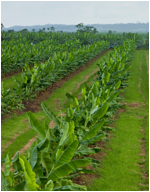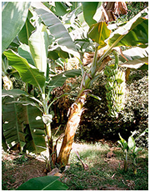Banana is the common name for herbaceous plants of the genusMusa and for the fruit they produce. It is one of the oldest cultivated plants. They are grown in at least 107 countries, primarily for their fruit, and to a lesser extent to make fiber, banana wine and as ornamental plants. Its fruits, rich in starch, grow in clusters hanging from the top of the plant. They come in a variety of sizes and colors when ripe, including yellow, purple, and red. In popular culture and commerce, "banana" usually refers to soft, sweet "dessert" bananas. The banana plant is the largest herbaceous flowering plant. The plants are normally tall and fairly sturdy and are often mistaken for trees, but their main or upright stem is actually a pseudostem that grows 6 to 7.6 metres (20 to 24.9 ft) tall, growing from a corm. Each pseudostem can produce a single bunch of bananas. After fruiting, the pseudostem dies, but offshoots may develop from the base of the plant. Many varieties of bananas are perennial.
Leaves are spirally arranged and may grow 2.7 metres (8.9 ft) long and 60 cm (2.0 ft) wide. They are easily torn by the wind, resulting in the familiar frond look.
Each pseudostem normally produces a single inflorescence, also known as the banana heart. inflorescence contains many bracts between rows of flowers. The female flowers appear in rows further up the stem from the rows of male flowers. The ovary is inferior, meaning that the tiny petals and other flower parts appear at the tip of the ovary.
The banana fruits develop from the banana heart, in a large hanging cluster, made up of tiers (called hands), with up to 20 fruit to a tier. The hanging cluster is known as a bunch, comprising 3–20 tiers, or commercially as a "banana stem", and can weigh from 30–50 kilograms (66–110 lb). In common usage, bunch applies to part of a tier containing 3–10 adjacent fruits.
Individual banana fruits (commonly known as a banana or 'finger') average 125 grams (0.28 lb), of which approximately 75% is water and 25% dry matter. There is a protective outer layer (a peel or skin) with numerous long, thin strings (the phloembundles), which run lengthwise between the skin and the edible inner portion. The inner part of the common yellow dessert variety splits easily lengthwise into three sections that correspond to the inner portions of the three carpels.
The fruit has been described as a "leathery berry". In cultivated varieties, the seeds are diminished nearly to non-existence; their remnants are tiny black specks in the interior of the fruit.Bananas are naturally slightly radioactive, more so than most other fruits, because of their potassium content and the small amounts of the isotope potassium-40 found in naturally occurring potassium.
Bananas contained large seeds, diploid or polyploid cultivars (some being hybrids) with tiny seeds are preferred for human raw fruit consumption. These are propagated asexually from offshoots. The plant is allowed to produce two shoots at a time; a larger one for immediate fruiting and a smaller "sucker" or "follower" to produce fruit in 6–8 months. The life of a banana plantation is 25 years or longer, during which time the individual stools or planting sites may move slightly from their original positions as lateral rhizome formation dictates.
Cultivated bananas are parthenocarpic, which makes them sterile and unable to produce viable seeds. Lacking seeds, propagation typically involves farmers removing and transplanting part of the underground stem (called a corm). Usually this is done by carefully removing a sucker (a vertical shoot that develops from the base of the banana pseudostem) with some roots intact. However, small sympodial corms, representing not yet elongated suckers, are easier to transplant and can be left out of the ground for up to two weeks; they require minimal care and can be shipped in bulk.
Bananas are picked green, and ripen in special rooms upon arrival in the destination country. These rooms are air-tight and filled with ethylene gas to induce ripening.
| Nutritional value per 100 g (3.5 oz) | |
| Energy | 371 kJ (89 kcal) |
| Carbohydrates | 22.8g |
| - Sugars | 12.23 g |
| - Dietary fiber | 2.6 g |
| Fat | 0.33 g |
| Protein | 1.09 g |
How to Control Banana Disease
Herbaceous flowering plants from the genus Musa family are commonly known as Bananas. It is the oldest cultivated fruit all around the globe. Banana plants are often referred as trees owing to the reasons- it’s tall and sturdy. Banana plants are basically cultivated cause of their healthy banana fruits. These tropical plants are prone to a range of possibly serious diseases. Some of the major diseases found in banana plants are- Cladosporium speckle, Yellow sigatoka, Banana streak virus(BVS), Black sigatoka, Matooke wilt and Fusarium wilt, whereas, some of the minor diseases comprise of Corm rot (Armellaria), Cigar end disease and Cucumber mosaic virus.
The cheapest and most effective way of controlling banana plant disease is by employing host plant resistance. Although, these resistant plants are not available but they are developed, these resistant hybrid plants are formulated from exotic bananas and are currently available in our nation.
One of the most serious diseases pertaining in banana plants Black Leaf Streak Disease; this is the most damaging foliar disease. This disease results in shocking loss in the productivity of the fruit. The only remedy to control Black Leaf Streak Diseaseis the usage of oil and fungicides. The application of this oil and fungicides needs to be done frequently, approximately 5-6 times round the year. Oil and fungicides has many adverse effects on the environment and health of human beings, hence, its usage has to be done in a controlled way.
Best recipe is for banana breakage, farmer has focus to bacteria infection by way of antiback injection treatment on banana plant. So that diseases can be control upto 95% with in 5-6 days only.
Note: We had trained to farmers to develop various Vegetables and Fruits as per buyer specification
How to Control Banana Breakage
To control breakage of banana in by injecting anti-bacterial treatment plants and it takes five/seven days up to 95% can be control Reduce watering & to develop zone apply Humic acid in soil.
| Before | After |
|---|---|
| |
|
How to Increase a Banana Production
- Plants nutrition’s management.
- Plants fertilization management.
- Plants watering management.
- Plants all disease control.
- The size the best recipe for healthy and bulk production
 Contact Us:
Contact Us: 

